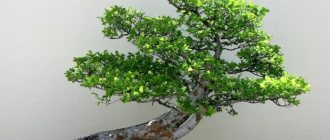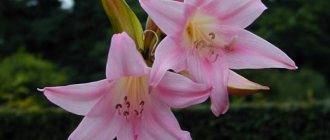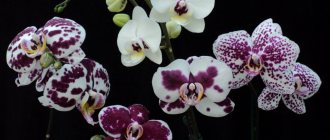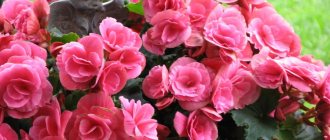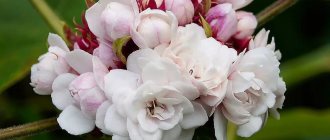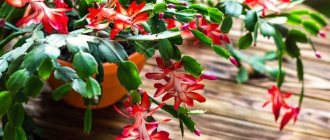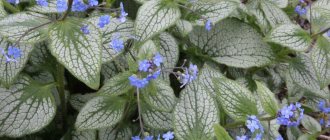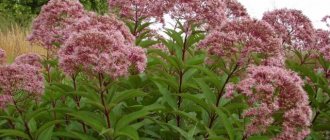We consider why the beautiful dicentra began to slowly displace roses, peonies and gladioli, why modern gardeners prefer to plant something new instead of the traditional one, which it brings to the appearance of the site. After reading the article, everyone will understand where it is best to plant dicentra, how to care for it, and how to combine the plant with other plantings.
Dicentra is beautiful - a new garden crop
Features of culture
The beautiful Dicentra is just beginning to win the hearts of ordinary gardeners. North America is considered its homeland. The flower came to Europe in the nineteenth century. Traders brought it from Japan. There the culture is very popular and has been elevated to the rank of a national treasure, like sakura.
A bright flower looks good against the backdrop of garden greenery
The beautiful Dicentra grows forty centimeters in height. Its peduncle is higher than the peduncle of other varieties; the shape of the buds is similar to a human heart. They gather in clusters, hang beautifully on the branches and emit a light, pleasant aroma that does not irritate the sense of smell, but only slightly excites its receptors. As they bloom, the flowers take on a soft pink or lavender color. It pleases the eye from the beginning of summer until the end of September.
Soft pink color
A beautiful dicentra in landscape design is used for group plantings, to decorate borders and driveways. It can be grown in free-standing flowerpots or in pots on windowsills.
Beautiful frame of stone paths
Dicentra in mixborder
Low varieties are ideal for creating mixborders; they look great next to kupena and lungwort. The combination of plants with tulips, tails and daffodils is effective. A beautiful dicentra can become a beautiful decoration for a rock garden. Try planting it and ferns nearby in the shade; you will see how easily you can arrange an area where other light-loving flowers do not grow.
The flower grows well among the stones
Original compositions are obtained from flower sections. They add color to the design of any special event. Flowers look great in photos, the pictures turn out bright and memorable. Therefore, today dicentra is actively used for floral decoration of various special events.
Dicentra looks very picturesque in the photo
How to plant in open ground
What time to disembark?
The plant is planted in open ground from the last days of April to the first days of May, and also in September. When planting in autumn, it should be taken into account that the flower must take root well and develop a root system before the arrival of winter frosts. For such a plant, you can choose a well-lit area or one in slight shade. However, in a sunny place, the flowering of dicentra can be seen much faster. This plant can be grown on any soil, but the best option for it is light, well-drained, moderately moist and nutrient-rich soil. The soil for planting should be prepared in advance. If you plant a plant in the spring, then take care of preparing the site for it in the autumn months, and vice versa, if planting is scheduled for autumn, then you need to prepare the site in the spring. The earth needs to be dug up to the depth of a spade bayonet, and humus should be added to it (per 1 square meter from 3 to 4 kg of fertilizer), then the earth should be spilled with a nutrient solution prepared from mineral fertilizer (20 grams of the substance per bucket of water).
How to plant
The first step is to prepare the planting holes for the flowers. Their diameter and depth should be 0.4 m, and it is necessary to maintain a distance between bushes of 0.5 m. At the bottom you need to make a drainage layer of broken brick or crushed stone. Then a layer of garden soil is poured into it, which must first be mixed with compost. Then you need to lower the plant into the hole and fill it with the same mixture of garden soil and compost. If the soil is too heavy, then it can be combined with sand, and if you add limestone chips to the soil, then the center will only be better for it.
Necessary conditions for growth and flowering
There are general provisions - rules of care that must be observed when growing any variety of dicentra. The flower is a shade-loving plant, so it does not do well in a sunlit area. It is better to plant it under trees in shaded areas. Then the flowering period will last longer, the color of the buds will be richer.
Feels better in the shade of the dicenter than in the sun
It is necessary to water the flower often, especially on hot days, but do not allow water to stagnate: the roots quickly begin to rot. In order for the beautiful dicentra to take root well, it is important to fill the holes with drainage before planting, and fill the remaining space with loose soil, half mixed with compost. Add limestone chips there, and the plant will reward you with good growth and lush flowering.
Lush flowering plant
Proper care
Dicentra is unpretentious; if everything was done correctly, it will grow well on its own. The main thing is to monitor watering: you cannot overdry the flower, you cannot overwater it. Constantly loosening the soil around the bush has a beneficial effect on growth. You need to start doing it from the moment the first green shoots appear.
Loosening the plant has a beneficial effect on its growth
Since the root system is located superficially, this must be done very carefully. Experienced gardeners use a trident to loosen the soil. If frosts occur in the spring, it is better to cover the young shoots with thick fabric. Otherwise they will die.
Protecting plants from frost with rags
See also: Catalog of popular house projects in chalet and eclectic styles
During flowering, it is important to promptly remove inflorescences that have already faded. It is also useful to cut off faded leaves, leaving neat stumps instead. Then the bush will look neat and very picturesque.
In winter, the plant remains in the ground. In northern latitudes it is covered with a thick layer of peat. In southern latitudes there is no need to do this, otherwise the flower will freeze and die.
The first flower feeding is done in early spring
The plant needs to be fed several times a season. The first fertilizing is done in early spring, then superphosphate fertilizer is applied to the soil. The second feeding is carried out during the appearance of the first flowers. Adding nitrogen-containing fertilizers to the soil will extend the flowering period of the bush. The last feeding is done in the fall. During this period, the roots are watered with infusion of manure.
Ready-made manure tincture
Reproduction
Practice shows that planting flower seeds does not allow you to get a beautiful flowering bush in the first year of growth. The seeds germinate poorly; if they take root, the dicentra begins to bloom only in the third year. Nurseries can afford to wait for this result, so they plant the seeds in the ground in late autumn, and then cover the plantation with plastic wrap.
Sowing seeds under film
Gardeners prefer to use other methods of propagation - division and cuttings. These operations are carried out every four years. If this is not done, the roots of the flower grow greatly and begin to rot.
Propagation of flowers by division
See also: Catalog of companies that specialize in the development and implementation of landscape design work
Root division can be done twice a year: either in early spring or late autumn, when the active phase of plant growth stops. It is carefully dug up, the roots are separated with a knife in such a way that three or four good large shoots remain in each new bush. Immediately after the operation, the divisions are planted in pre-prepared holes. Remember! A drainage layer must be laid on their bottom.
Drainage for planting
Note! If several separated bushes are placed in one hole at once, already in the first year of growth the plant will form into a lush flower.
Cuttings are done a little differently. The bush is undermined from the side of young shoots. The shoots are cut with a knife, including part of the root, and then immediately planted in the greenhouse and watered well. And when the plant takes root well (next spring), it is then dug up and transferred to open ground.
How a flower cutting is formed
Note! Dicentra beautiful has very poisonous roots - planting and care for this reason should only be done with rubber gloves. If you ignore the use of protective equipment, you can get burns on your hands. There are cases where such trauma led to damage to the central nervous system.
Personal protective equipment
In order for the plant to survive the winter, its branches need to be cut off in the fall, leaving small stumps five centimeters high on the surface of the soil. Experts recommend immediately treating the edges of the cut with a mixture of humus and peat.
A mixture of humus and peat
Landing dicenters
Dicentra is an exceptionally moisture-loving plant; it needs drained, well-moistened soils with a sufficient amount of humus.
But if the water stagnates, then its large roots quickly rot; take this nuance into account when you begin to plant dicentra on your site. You can choose any corner of the garden for planting dicentra. On the sunny side it blooms faster, but the bush itself remains small. In the shade, the bush grows strongly, and the flowers bloom a little later, but the flowering period increases.
I planted it in ]peonies[/anchor] and primroses (as advised by experienced gardeners). As a result, I got an incomparably beautiful “bouquet” in the flowerbed. Dicentra is very friendly and gets along well with other types of plants. I experimented with peonies and primroses, and my neighbor at the dacha decorated the patio behind the dacha house: he planted three varieties of dicentra in combination with Altai doronicum and white daffodils. It turned out quite impressive.
Other plant varieties
In addition to the beautiful dicentra, there are other varieties. Dicentra splendid is considered more popular. She is the largest. An adult plant grows up to one and a half meters in height. The bush becomes lush and voluminous. In mid-summer it is completely covered with pink or white flowers. Such splendor looks very impressive, as evidenced by the following photo.
Dicentra is magnificent in all its glory
In landscape design, the magnificent dicentra is often used as a soloist. It is also planted in group plantings to form the background. With its help you can fill the farthest corners of the garden and cover the most unsightly places with it. If you plant bushes along the fence, they will tear down most of it.
Gorgeous dicentra bush – beautiful soloist
Dicentra superb looks like a fern. It is ideal for decorating alpine slides and for creating the lower tier of coniferous group plantings. Its inflorescences are pale pink. It perfectly refreshes the monotonous green range of evergreens.
Lush dicentra is excellent
Dicentra climbing - liana. It blooms with yellow buds and wraps itself around any obstacle, but its foliage does not completely hide the base. This species does not tolerate cold well, so it is difficult to grow in the northern climatic zones of Russia.
Dicentra climbing - creeping vine
Dicentra vagabond, on the contrary, tolerates cold well and thrives in mid-latitudes. It likes to settle in cracks between stones, on soils covered with crushed stone or sand, so it is better to plant the plant on natural slopes. It grows up to 20 cm in height, the roots are very short, located in the upper layers of the soil. The flowers are large, but there are not many of them. The photo shows what they look like during flowering (from July to September).
Dicentra vagrant tolerates cold well
general information
It is believed that the birthplace of dicentra is Japan, but it has been cultivated all over the world for many years. Depending on the variety, there are annual and perennial varieties. But they all differ in the same original inflorescences.
Dicentra grows up to 1 m and develops a very powerful root system that goes deep into the ground. The most common shades are all variations of white, pink and crimson. Surprisingly, dicentra is a poppy plant. Herbaceous stems are straight or branched, with complex bluish leaves.
Photo: u-mama.ru
Flower Broken Heart – photo
The Broken Heart flower is a real curiosity in the garden. It simply has no competitors with the same unusual type of inflorescences and buds. Just look!
Photo: gavrishira.blogspot.com
Photo: wallpapersafari.com
Photo: rachelwilliamsonline.com
Photo: victoriadailyphoto.blogspot.com
Photo: dacha73.ru
Photo: plantarium.ru
Photo: asienda.ru
Photo: nn.ru
Photo: pinterest.ru
Photo: polezno-znat.ru
Photo: thespruce.com
Photo: ladyflor.ru
Photo: lovely-dom.ru
Photo: sady-msk.ru
Photo: commons.m.wikimedia.org
Photo: flo.discus-club.ru
Photo: commons.m.wikimedia.org
Photo: zen.yandex.ru
Photo: reddit.com
Photo: zen.yandex.ru
Photo: oir.mobi
Photo: fotoshkola.net
Photo: jhoppers.japanhostel.net
Photo: windowssearch-exp.com
Photo: photo.99px.ru
Photo: avto.goodfon.ru
Did you like the post? Subscribe to our channel in Yandex.Zen, it really helps us in our development!
